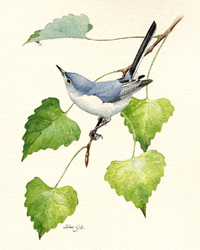Breeding Bird Atlases (BBA)
Find a Bird - BBA1
Breeding Bird Atlas 1 Species Accounts
Blue-gray Gnatcatcher
Polioptila caerulea
Egg Dates
May 10 to June 18
Number of Broods
one; may renest if first attempt fails.

The Blue-gray Gnatcatcher is yet another member of the southern avifauna that has recently spread into Massachusetts and the northeastern United States. Prior to 1960, it was regarded only as a transient, with the bulk of the observations from late August to early September. Since 1960, the gnatcatcher has experienced a steady increase, both as a spring and fall migrant and also as an uncommon and somewhat local summer resident in every geographical region of the state. The gnatcatcher has a distinct affinity for water margins—wooded edges along ponds, streams, and the edges of Red Maple swamps. Nesting records are concentrated along the major river valleys and at Quabbin, where the increase in Beaver numbers and their associated wetlands provide ideal habitat. According to Atlas figures, it was estimated that in 1976 there were 20 to 30 pairs of gnatcatchers nesting in Quabbin.
The first resident gnatcatchers arrive in mid-April, and from then until the end of the month the remaining residents filter in, although migrants may be noted until mid-May. Observers familiar with the high, thin speee call note are likely to be the first to encounter this sprite because it is constantly vocal while flitting about in the treetops. The song is a lengthy series of thin, squeaky, wheezy notes often easily overlooked but occasionally sung with remarkable intensity. Shortly after the arrival of the female, as much as a week later than the male, nest construction begins. The nest is an architectural wonder, a compact, cuplike structure affixed firmly to a horizontal branch at heights of up to 70 feet but generally under 25 feet. Massachusetts nests have been found in Red Maple at heights ranging from 10 to 20 feet, and one was discovered at 16 feet in an oak in a dry area (Meservey, Kellogg). The exterior of the nest is adorned with lichens held in place by spider silk, while the nest consists mostly of plant down and similar components, including the buffy wood from the stalk of Cinnamon Fern. Once the nest is completed, it may be as long as two weeks before the eggs are laid, when the trees have leafed out. The delay between nest completion and egg laying has been attributed to the fact that essential nesting material is available only during this short time span. If the nest site is later deemed unsuitable or a renesting attempt occurs, the material from the original nest is systematically disassembled and used to build a new nest. Nest-building activity has been observed in Massachusetts from late April to mid-June.
Once the normal clutch of four or five eggs is completed, both sexes share the incubation for about 13 days. The young remain in the nest for about two weeks and are fed by both parents. Nestlings have been reported in the Commonwealth from June 18 to July 8 (Meservey, BOEM). Once the young leave the nest, they remain in the company of the adults for an additional two to three weeks. Pairs or single adults have been observed in the state feeding fledglings from July 2 to August 1 (Meservey). By late July onward, gnatcatchers begin to roam the woodlands with groups of chickadees and warblers prior to migration.
Most residents depart from mid-August to mid-September, although scattered individuals are occasionally reported in October and November. Gnatcatchers winter in the southernmost states through Mexico to Honduras and on a few Caribbean islands. Wintering birds in the continental United States are occasionally subject to mortality during severe winter cold.
Map Legend and Data Summary
Atlas 1 data collected from 1975-1979


Note: uncommon but increasing in moist woodlands and along lowland watercourses
Robert B. Coyle



